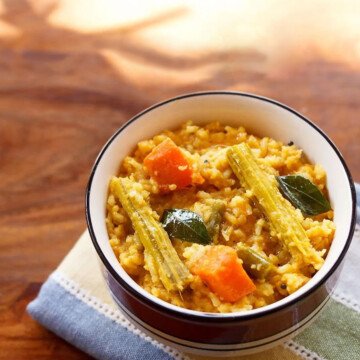
Sambar Rice
Sambar Rice is a South Indian dish featuring rice served with sambhar, a spicy lentil stew made with toor dal and assorted vegetables. Flavored with tamarind and spices, it's a nutritious meal often enjoyed with pickles or papad.
Ingredients
For Sambar:
- 1 Cup Toor dal (pigeon peas)
- 2 Cup Mixed vegetables (carrot,beans, potato, pumpkin, etc.) chopped
- 2 tablespoon Tamarind paste
- 2 tablespoon Sambhar powder (store-bought or homemade)
- 1 teaspoon Mustard seeds
- 1 teaspoon Cumin seeds
- 2 Dry red chilies
- ½ teaspoon Fenugreek seeds
- ½ teaspoon Turmeric powder
- ¼ teaspoon Asafoetida (hing)
- 2 tablespoon Oil
- Salt to taste
- Fresh coriander leaves a handful, chopped
For Rice:
- 1 Cup Rice
- 2 Cup Water
Instructions
Cooking Rice
- Firstly, begin by choosing the right rice! You can use regular white rice, basmati, or any rice you like.
- Secondly, wash the rice thoroughly to remove excess starch, which will keep it from getting too sticky.
- Thirdly, cook the rice using a pressure cooker or rice cooker. If you're using a pressure cooker, add the rice and water in a 1:2 ratio. For a rice cooker, follow the instructions for your specific model.
- Lastly, ensure that the rice is fluffy, not mushy. No sooner than it’s cooked, fluff it with a fork to keep the grains separate.
Making the Sambar
A. Tadka (Tempering the Spices)
- Firstly, heat oil in a pan and add mustard seeds, cumin, curry leaves, and dried red chilies to the hot oil. Listen for that satisfying crackle!
- Afterwards, cook them for a few seconds until they release their wonderful fragrance.
Cooking Toor Dal
- Meanwhile, cook the toor dal (yellow lentils) in a pressure cooker until soft and creamy. As a result, the dal will become thick and smooth.
- Additionally, you can add some water to get the perfect creamy consistency.
Adding Vegetables
- Next, add your veggies like carrots, potatoes, and tomatoes to the cooked dal. As an illustration, potatoes give it a great texture, while tomatoes add flavor!
- After that, let the vegetables cook until they’re tender.
Tamarind Magic
- Now, for the tamarind pulp! Add some tamarind to the dal and veggie mix. This will give your sambar that perfect balance of tangy and rich flavor.
- As a matter of fact, tamarind is key to making the sambar deliciously bold and flavorful.
Simmering the Sambar
- Subsequently, let everything simmer for a few minutes to allow the spices and flavors to meld together. At this point, the aroma will fill your kitchen, and you’ll be so ready for the next step!
Combining Sambar with Rice
- Afterward, check the consistency of your sambar. If it’s too thick, add a little water to thin it out. But if it’s too watery, let it simmer a little longer. You want it to coat the rice perfectly—not too runny, but also not too thick.
- Now that both the rice and sambar are ready, carefully mix them together. You can combine them in a big bowl or directly on your plate. 🍽️
- Finally, mix well and enjoy!
Notes
Flavor Variations: Customizing Your Sambar Rice
Imagine you're cooking with friends, and everyone likes different flavors. Here’s how to make it perfect for all!Spicy vs. Mild
If your friend loves spice, add more green chilies or red chili powder. But, if someone prefers it mild, use gentle sambar powder for a softer taste.Add-ins for Extra Flavor
-
- Coconut: Makes it creamy and smooth.
-
- Jaggery: Adds a touch of sweetness to balance the tang.
-
- Curry Leaves: Fresh leaves give a fragrant finish.
Veggie Twists
Try adding mushrooms, zucchini, or pumpkin for a fun twist. Or, go for a colorful mix of veggies for more flavor and nutrients!Protein Power
Pair it with chicken or fish curry if you want extra protein.Tips & Tricks for Perfect Sambar Rice
1. Perfecting the Tadka: Firstly, make sure to temper your spices at the right temperature—too hot and they’ll burn! On the other hand, when you add fresh curry leaves at the right moment, they give your sambar a delicious aroma. In this case, timing is key! 2. Avoiding Overcooked Rice: As a matter of fact, nobody likes mushy rice! To avoid overcooking, add the rice to the sambar carefully and only cook until the grains are fluffy. That way, they’ll stay nice and separate. 3. Getting the Right Consistency: For instance, if your sambar is too thick, just add some water or veggie stock. Conversely, if it’s too runny, simmer it a bit longer to thicken up. So, you can adjust it to be just right! 4. Storing Leftovers: Afterward, if you have leftover sambar rice, store the sambar and rice separately to keep them fresh. That way, when you reheat, the flavors stay amazing! Without a doubt, this trick will save you from soggy rice and tasteless sambar.Nutrition
Nutrition Facts
Sambar Rice
Amount per Serving
Calories
1325
% Daily Value*
Fat
33
g
51
%
Saturated Fat
5
g
31
%
Polyunsaturated Fat
2
g
Monounsaturated Fat
4
g
Sodium
10
mg
0
%
Potassium
2366
mg
68
%
Carbohydrates
196
g
65
%
Fiber
24
g
100
%
Sugar
15
g
17
%
Protein
47
g
94
%
Vitamin A
3000
IU
60
%
Vitamin B1
0.2
mg
13
%
Vitamin B2
0.1
mg
6
%
Vitamin B3
2
mg
10
%
Vitamin B5
0.5
mg
5
%
Vitamin B6
0.3
mg
15
%
Vitamin C
26
mg
32
%
Vitamin E
1
mg
7
%
Vitamin K
3
µg
3
%
Calcium
166
mg
17
%
Iron
8.8
mg
49
%
* Percent Daily Values are based on a 2000 calorie diet.
Tried this recipe?Let us know how it was!